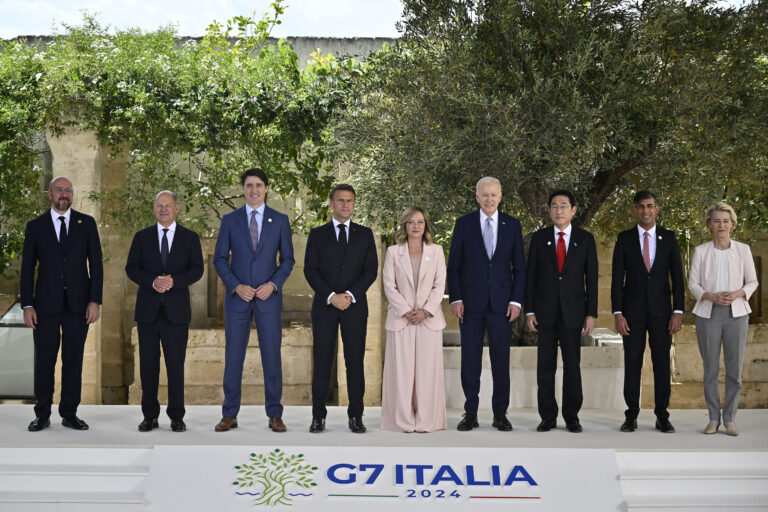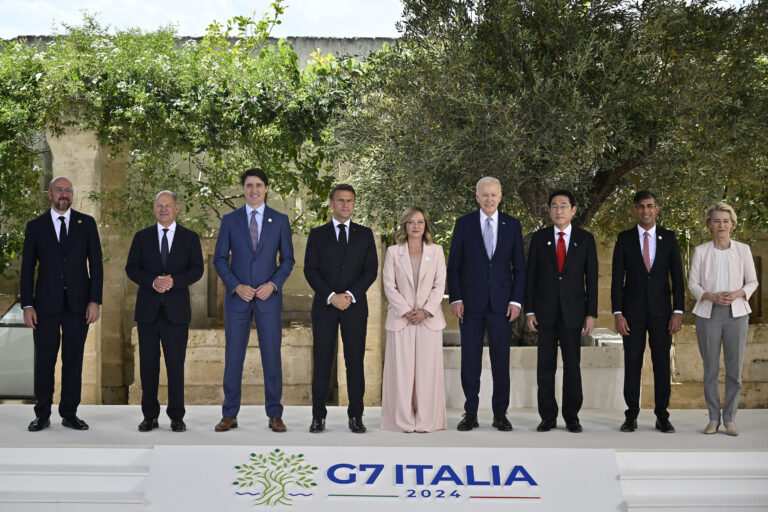
It’s been a decade since the Group of Seven kicked Russia out. Now the U.S.-led club accounting for 44% of the global economy has come to terms with its limitations while embracing its resilience.
Both China and Russia are having success wooing emerging economies in the loosely-defined Global South and view the U.S. and its allies as aggressors who foment war and use sanctions to achieve their geopolitical goals. The G-7 is wooing the same countries and, at a summit this week in Southern Italy, has found a creative solution on how to use the interest from Russian frozen assets to support Ukraine.
The problem is that several of the leaders landing in Apulia are in dire straits back home. U.S. President Joe Biden is behind Donald Trump in many polls ahead of November elections. U.K. Prime Minister Rishi Sunak is on track for defeat in July. France’s Emmanuel Macron is batting away rumors he’d quit in a snap legislative election he didn’t need to call next month.
Faced with two brutal wars, can the G-7 muster enough economic, military and persuasive power to stave off the biggest threats to the democratic-led global order since World War II? The battle lines of this new era of geo-economic fragmentation are drawn.
Defense Spending
No issue illustrates the G-7’s isolation better than Ukraine. The group and the European Union have provided the vast majority of aid and foreign military support — while nearly every other nation has mostly avoided the fray or even aligned with Russia.
The Ukraine conflict combined with China’s military build-up has raised doubts about G-7 military dominance, including whether the U.S. would conceivably be able to both help defend Ukraine, while also responding to any invasion of Taiwan.
While Russian defense spending has spiked, the G-7’s remains stable — including several countries that are under the 2% of GDP target set for NATO members, a key gripe of Trump.
Of course, Russia’s smaller economy means that even the doubling of spending as a share of GDP due to the war is roughly the same amount in money terms as the much more modest increase that Germany has planned, according to Bloomberg Economics.
For the G-7, defending Ukraine is a matter of principle and a defense of democracy itself. For many other nations, it’s just another sign of a multipolar world and the loosening reach of the West.
Sanctions initially united the G-7 around severing their bilateral trade with Russia, but diverting goods through third countries still allows Moscow to wage war. Germany’s exports to Kazakhstan, for instance, have jumped since Russia’s February 2022 invasion. Also, China has filled in the gaps Russia needs by boosting their bilateral trade. The U.S. this week moved to curb reselling of goods to Russia, widening enforcement on chips made and sold abroad.
“On both counts – China and trade diversion via third countries – there’s a big problem,” said Robin Brooks, a senior fellow at the Brookings Institution in Washington. “Russia isn’t economically isolated.”
Economic Vitality
Over the past 10 years, the world’s center of economic gravity has shifted further away from the West and will likely flip sides before the end of the next decade. The G-7 economies are on track to be eclipsed by the rest of the G-20 in terms of gross domestic product by 2030, according to a Bloomberg analysis of World Bank data.
Part of the G-7’s problem: a malaise since the global financial crisis, marked by stagnant living standards, woeful productivity gains and a shift down in growth rates amid soaring public debt.
At the same time, their populations are aging faster than counterparts in the G-20: Half of India’s 1.4 billion population is younger than 30 years old, while about one-fifth of people in the G-7 are currently over 65.
The aging workforces cloud longer-term fiscal outlooks and leave the world’s richest economies with little capacity to absorb the next shock. Of the seven, only Germany has a lower debt level than 10 years ago, and most are expected to keep piling on borrowing rather than build buffers in the coming years.
Meanwhile, Asian economies have enjoyed rapid growth, fueled by an expanding population, globalization and an emerging middle class.
“For China in particular, and for other large, fast-growing emerging markets such as India, this expanding economic power is a necessary pre-condition for their increasing geopolitical clout,” said Ben Bland, director of the Asia-Pacific program at Chatham House.
Trade
Coming out of the Second World War, free trade was seen as the path to prosperity. Now the focus is on economic statecraft. That involves intervention in markets and protectionist industrial policies that feel increasingly like war by other means.
Industrial policies — whether they consist of government subsidies, tax breaks or other incentives — have moved from being maligned by the West to becoming the mainstream in Washington, and the subject of growing interest in Brussels.
Once a vocal critic of the U.S.’s Inflation Reduction Act, the European Union is debating its own industrial protections because, as former Italian Prime Minister Mario Draghi put it this year, “other regions are no longer playing by the rules.” The bloc plans to raise levies on Chinese electric vehicles starting next month, escalating trade tensions further.
Perhaps uniting around such worries, G-7 finance chiefs preparing for this week’s leaders’ summit marked the change in strategy by singling out China in their communiqué and promising to consider measures to ensure a level playing field.
Many steps have already been taken unilaterally, with the G-7 meeting coming shortly after the Biden administration’s announcement to reimpose tariffs on hundreds of goods imported from China. The EU, meanwhile, announced the results of a probe into Chinese subsidies for EVs that could also lead to tariffs.
Even if there’s some unity within the G-7 about deploying these economic tools against China, it’s not lost on Beijing that the emphasis is on punishing competitors — not rewarding friends. Everyone is acutely aware that so-called carrots as well as sticks will need to be wielded to bring the Global South onside.
For all its challenges, the bloc remains one of the few international groupings that can mount the kind of massive financial response that’s helped Ukraine fight Russia’s invasion or aspire to set the agenda on major global issues.
“There’s no multilateral grouping that’s been effective as the G-7 across multiple fronts,” said Caitlin Welsh, a former U.S. official now with the Center for Strategic & International Studies in Washington.
___
© 2024 Bloomberg L.P
Distributed by Tribune Content Agency, LLC.
American Military News Rephrased By: InfoArmed
